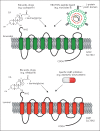Bile Acid Uptake Transporters as Targets for Therapy
- PMID: 28249291
- PMCID: PMC5516419
- DOI: 10.1159/000450983
Bile Acid Uptake Transporters as Targets for Therapy
Abstract
Bile acids are potent signaling molecules that regulate glucose, lipid and energy homeostasis predominantly via the bile acid receptors farnesoid X receptor (FXR) and transmembrane G protein-coupled receptor 5 (TGR5). The sodium taurocholate cotransporting polypeptide (NTCP) and the apical sodium dependent bile acid transporter (ASBT) ensure an effective circulation of (conjugated) bile acids. The modulation of these transport proteins affects bile acid localization, dynamics and signaling. The NTCP-specific pharmacological inhibitor myrcludex B inhibits hepatic uptake of conjugated bile acids. Multiple ASBT-inhibitors are already in clinical trials to inhibit intestinal bile acid uptake. Here, we discuss current insights into the consequences of targeting bile acid uptake transporters on systemic and intestinal bile acid dynamics and discuss the possible therapeutic applications that evolve as a result.
© 2017 S. Karger AG, Basel.
Figures


Similar articles
-
The influences of cholecystectomy on the circadian rhythms of bile acids as well as the enterohepatic transporters and enzymes systems in mice.Chronobiol Int. 2018 May;35(5):673-690. doi: 10.1080/07420528.2018.1426596. Epub 2018 Jan 30. Chronobiol Int. 2018. PMID: 29381405
-
Bile acid transporters: structure, function, regulation and pathophysiological implications.Pharm Res. 2007 Oct;24(10):1803-23. doi: 10.1007/s11095-007-9289-1. Epub 2007 Apr 3. Pharm Res. 2007. PMID: 17404808 Review.
-
n-3 Fatty Acids Abrogate Dyslipidemia-Induced Changes in Bile Acid Uptake, Synthesis, and Transport in Young and Aged Dyslipidemic Rats.Lipids. 2019 Jan;54(1):39-51. doi: 10.1002/lipd.12125. Epub 2019 Feb 10. Lipids. 2019. PMID: 30740707
-
Targeting the Four Pillars of Enterohepatic Bile Salt Cycling; Lessons From Genetics and Pharmacology.Hepatology. 2021 Jun;73(6):2577-2585. doi: 10.1002/hep.31651. Epub 2021 May 24. Hepatology. 2021. PMID: 33222321 Free PMC article. Review.
-
Identification of Triterpene Acids in Poria cocos Extract as Bile Acid Uptake Transporter Inhibitors.Drug Metab Dispos. 2021 May;49(5):353-360. doi: 10.1124/dmd.120.000308. Epub 2021 Mar 3. Drug Metab Dispos. 2021. PMID: 33658229
Cited by
-
Cholestasis: exploring the triangular relationship of gut microbiota-bile acid-cholestasis and the potential probiotic strategies.Gut Microbes. 2023 Jan-Dec;15(1):2181930. doi: 10.1080/19490976.2023.2181930. Gut Microbes. 2023. PMID: 36864554 Free PMC article. Review.
-
Bile-ology: from bench to bedside.J Zhejiang Univ Sci B. 2019 May;20(5):414-427. doi: 10.1631/jzus.B1900158. J Zhejiang Univ Sci B. 2019. PMID: 31090267 Free PMC article. Review.
-
Advances in pediatric non-alcoholic fatty liver disease: From genetics to lipidomics.World J Clin Pediatr. 2022 Mar 23;11(3):221-238. doi: 10.5409/wjcp.v11.i3.221. eCollection 2022 May 9. World J Clin Pediatr. 2022. PMID: 35663007 Free PMC article. Review.
-
A novel bioluminescence-based method to investigate uptake of bile acids in living cells.Am J Physiol Gastrointest Liver Physiol. 2018 Oct 1;315(4):G529-G537. doi: 10.1152/ajpgi.00133.2018. Epub 2018 Jun 21. Am J Physiol Gastrointest Liver Physiol. 2018. PMID: 29927324 Free PMC article.
-
Double Trouble: How Microbiome Dysbiosis and Mitochondrial Dysfunction Drive Non-Alcoholic Fatty Liver Disease and Non-Alcoholic Steatohepatitis.Biomedicines. 2024 Feb 29;12(3):550. doi: 10.3390/biomedicines12030550. Biomedicines. 2024. PMID: 38540163 Free PMC article. Review.
References
-
- Russell DW. The enzymes, regulation, and genetics of bile acid synthesis. Annu Rev Biochem. 2003;72:137–174. - PubMed
-
- Hofmann AF, Sjövall J, Kurz G, et al. A proposed nomenclature for bile acids. J Lipid Res. 1992;33:599–604. - PubMed
-
- Hofmann AF. The enterohepatic circulation of bile acids in mammals: form and functions. Front Biosci (Landmark Ed) 2009;14:2584–2598. - PubMed
Publication types
MeSH terms
Substances
LinkOut - more resources
Full Text Sources
Other Literature Sources

